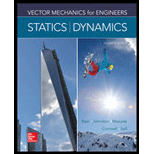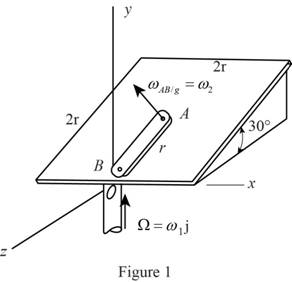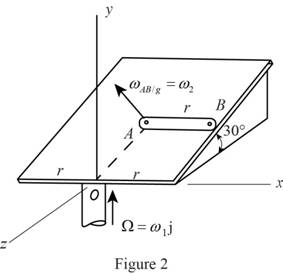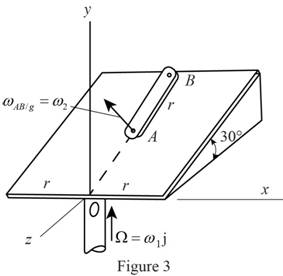
Concept explainers
(a)
The acceleration of end B of the rod if
(a)
Answer to Problem 15.244P
The acceleration of end B is
Explanation of Solution
Given information:
The side length of the square plate is
The shaft rotates with a constant angular velocity as
The constant angular velocity with respect to the plate is
Calculation:
Calculate the position of A with respect to O
Calculate the position of B with respect to O
Calculate the rate of rotation of the frame
Calculate the motion relative to the frame
For
Sketch the Free Body Diagram of the plate, the rod AB is located at an angle

Refer to Figure 1.
Calculate the position of B with respect to A
Calculate the position of B with respect to O
Substitute
Calculate the velocity at the point
Substitute
Calculate the velocity at the point B with respect to the frame
Substitute
Calculate the acceleration at the point
Substitute
Calculate the acceleration at B with respect to the frame
Substitute
Calculate the Coriolis acceleration
Substitute
Calculate the acceleration at B
Substitute
Hence, the acceleration of B is
(b)
The acceleration of end B of the rod if
(b)
Answer to Problem 15.244P
The acceleration of end B is
Explanation of Solution
Given information:
The side length of the square plate is
The shaft rotates with a constant angular velocity as
The constant angular velocity with respect to the plate is
Calculation:
For
Sketch the Free Body Diagram of the plate, the rod AB is located at an angle

Refer to Figure 2.
Calculate the position of B with respect to A
Calculate the position of B with respect to O
Substitute
Calculate the velocity at the point
Substitute
Calculate the velocity at the point B with respect to the frame
Substitute
Calculate the acceleration at the point
Substitute
Calculate the acceleration at B with respect to the frame
Substitute
Calculate the Coriolis acceleration
Substitute
Calculate the acceleration at B
Substitute
Hence, the acceleration of B is
(c)
The acceleration of end B of the rod if
(c)
Answer to Problem 15.244P
The acceleration of end B is
Explanation of Solution
Given information:
The side of the square plate of side
The shaft rotates with a constant angular velocity
The constant angular velocity with respect to the plate is
Calculation:
For
Sketch the Free Body Diagram of the plate, the rod AB is located at an angle

Refer to Figure 3.
Calculate the position of B with respect to A
Calculate the position of B with respect to O
Substitute
Calculate the velocity at the point
Substitute
Calculate the velocity at the point B with respect to the frame
Substitute
Calculate the acceleration at the point
Substitute
Calculate the acceleration at B with respect to the frame
Substitute
Calculate the Coriolis acceleration
Substitute
Calculate the acceleration at B
Substitute
Hence, the acceleration of B is
Want to see more full solutions like this?
Chapter 15 Solutions
Vector Mechanics for Engineers: Statics and Dynamics
- According to the principles and steps above, draw the kinematic diagram of following mechanisms. Mark the appropriate scale, calculates the degree of freedom. NO.1 NO.2 NO: 3 NO.: 4arrow_forwardAn office building is planned with a lateral-force-resisting system designed for earthquake resistance in aseismic zone. The seismic capacity of the proposed system, expressed as a force factor, is assumed tofollow a lognormal distribution with a median of 6.5 and a standard deviation of 1.5. The ground motionfrom the largest expected earthquake at the site is estimated to correspond to an equivalent force factor of 5.5.(a) What is the estimated probability that the building will experience damage when subjected to the largest expected earthquake? (b) If the building survives (i.e., experiences no damage) during a previous moderate earthquake with aforce factor of 4.0, what is the updated probability of failure of the building under the largest expectedearthquake?(c) Suppose future occurrences of the largest expected earthquake follow a Poisson process with a mean return period of 500 years. Assuming that damage events from different earthquakes are statisticallyindependent,…arrow_forwardDuring a plant visit, it was noticed that a 12-m-long section of a 10-cm-diameter steam pipe is completely exposed to the ambient air. The temperature measurements indicate that the average temperature of the outer surface of the steam pipe is 75°C when the ambient temperature is 5°C. There are also light winds in the area at 10 km/h. The emissivity of the outer surface of the pipe is 0.8, and the average temperature of the surfaces surrounding the pipe, including the sky, is estimated to be 0°C. Determine the amount of heat lost from the steam during a 10-h-long work day. Steam is supplied by a gas-fired steam generator that has an efficiency of 80 percent, and the plant pays $1.05/therm of natural gas. If the pipe is insulated and 90 percent of the heat loss is saved, determine the amount of money this facility will save a year as a result of insulating the steam pipes. Assume the plant operates every day of the year for 10 h. State your assumptions.arrow_forward
- An old fashioned ice cream kit consists of two concentric cylinders of radii Ra and Rb. The inner cylinder is filled with milk and ice cream ingredients while the space between the two cylinders is filled with an ice-brine mixture. Ice cream begins to form on the inner surface of the inner cylinder. To expedite the process, would you recommend rotating the inner cylinder? Justify your recommendation. icecream/ ice-brine Ra Rbarrow_forwardFind temperatures STRICTLY USING RITZ APPROXIMATION METHODarrow_forwardSolve this Problem using RITZ APPROXIMATION. STEP BY STEParrow_forward
- B/40 The body is constructed of a uniform square plate, a uniform straight rod, a uniform quarter‐circular rod, and a particle (negligible dimensions). If each part has the indicated mass, determine the mass moments of inertia of the body about the x‐, y‐, and z‐axes. Answer Given.arrow_forward(read image) Answer:arrow_forward(read image) Answer Givenarrow_forward
 Elements Of ElectromagneticsMechanical EngineeringISBN:9780190698614Author:Sadiku, Matthew N. O.Publisher:Oxford University Press
Elements Of ElectromagneticsMechanical EngineeringISBN:9780190698614Author:Sadiku, Matthew N. O.Publisher:Oxford University Press Mechanics of Materials (10th Edition)Mechanical EngineeringISBN:9780134319650Author:Russell C. HibbelerPublisher:PEARSON
Mechanics of Materials (10th Edition)Mechanical EngineeringISBN:9780134319650Author:Russell C. HibbelerPublisher:PEARSON Thermodynamics: An Engineering ApproachMechanical EngineeringISBN:9781259822674Author:Yunus A. Cengel Dr., Michael A. BolesPublisher:McGraw-Hill Education
Thermodynamics: An Engineering ApproachMechanical EngineeringISBN:9781259822674Author:Yunus A. Cengel Dr., Michael A. BolesPublisher:McGraw-Hill Education Control Systems EngineeringMechanical EngineeringISBN:9781118170519Author:Norman S. NisePublisher:WILEY
Control Systems EngineeringMechanical EngineeringISBN:9781118170519Author:Norman S. NisePublisher:WILEY Mechanics of Materials (MindTap Course List)Mechanical EngineeringISBN:9781337093347Author:Barry J. Goodno, James M. GerePublisher:Cengage Learning
Mechanics of Materials (MindTap Course List)Mechanical EngineeringISBN:9781337093347Author:Barry J. Goodno, James M. GerePublisher:Cengage Learning Engineering Mechanics: StaticsMechanical EngineeringISBN:9781118807330Author:James L. Meriam, L. G. Kraige, J. N. BoltonPublisher:WILEY
Engineering Mechanics: StaticsMechanical EngineeringISBN:9781118807330Author:James L. Meriam, L. G. Kraige, J. N. BoltonPublisher:WILEY





